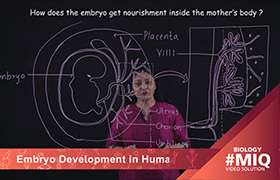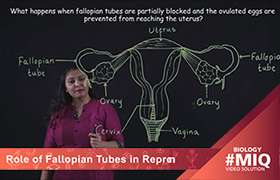CBSE Class 10 Answered
i) Natural methods work on the principle of avoiding chances of ovum and sperms meeting.
a) Periodic abstinence is one such method in which the couples avoid or abstain from coitus from day 10 to 17 of the menstrual cycle when ovulation could be expected. As chances of fertilisation are very high during this period, it is called the fertile period. Therefore, by abstaining from coitus during this period, conception could be prevented.
b) Withdrawal or coitus interruptus is another method in which the male partner withdraws his penis from the vagina just before ejaculation so as to avoid insemination.
c) Lactational amenorrhea (absence of menstruation) method is based on the fact that ovulation and therefore the cycle do not occur during the period of intense lactation following parturition. Therefore, as long as the mother breast-feeds the child fully, chances of conception are almost nil. However, this method has been reported to be effective only upto a maximum period of six months following parturition
ii) In barrier methods, ovum and sperms are prevented from physically meeting with the help of barriers. Such methods are available for both males and females.
a) Condoms are barriers used to cover the penis in the male or vagina and cervix in the female, just before coitus so that the ejaculated semen would not enter into the female reproductive tract. This can prevent conception.
b) Diaphragms, cervical caps and vaults are also barriers made of rubber that are inserted into the female reproductive tract to cover the cervix during coitus. They prevent conception by blocking the entry of sperms through the cervix.
iii) Intra Uterine Devices (IUDs) are devices are inserted by doctors or expert nurses in the uterus through vagina. IUDs increase phagocytosis of sperms within the uterus and the Cu ions released suppress sperm motility and the fertilising capacity of sperms. They are ideal contraceptives for the females who want to delay pregnancy and/or space children.
iv) Oral contraceptives - Oral administration of small doses of either progestogens or progestogenestrogen combinations is another contraceptive method used by the females. They are used in the form of tablets and hence are popularly called the pills. They inhibit ovulation and implantation as well as alter the quality of cervical mucus to prevent/ retard entry of sperms. Pills are very effective with lesser side effects and are well accepted by the females.
v) Injectables or implants - Progestogens alone or in combination with estrogen can also be used by females as injections or implants under the skin. Their mode of action is similar to that of pills and their effective periods are much longer.
vi) Surgical methods- Such methods also called sterilisation, are generally advised for the male/female partner as a terminal method to prevent any more pregnancies. Surgical intervention blocks gamete transport and thereby prevents conception. Sterilisation procedure in the male is called vasectomy and that in the female, tubectomy. In vasectomy, a small part of the vas deferens is removed or tied up through a small incision on the scrotum whereas in tubectomy, a small part of the fallopian tube is removed or tied up through a small incision in the abdomen or through vagina.











